If I had to boil down my Kyoto experience into just a few favorite moments: I would remember the incredibly friendly shopkeepers we met, the beauty of ancient temples and shrines, and singing while walking through Fushimi-inari with my best friend. Mari and I hummed/sang the Princess Mononoke song while walking from the top of Mt. Inari through the beautiful forest-covered mountain lined with orange, fading torii gates.
My best friend Mari and I sat down on her bedroom floor with her laptop in front of us.
“Where should we go over Obon week?” Mari asked me.
“I’d love to see Kyoto. It’s been a dream of mine for almost ten years. It’s gonna be a bit expensive though, as well as hot and crowded” I told her.
We started to do some research and make a list of pros and cons. We discussed a few options aside from Kyoto; such as Hokkaido, Okinawa, and even Nagano. We almost selected Nagano Prefecture as our destination. I wanted to see mountains and have a quiet getaway from the hustle and bustle of city life. How my heart has been longing for nature recently and missing my quiet hometown in Wisconsin.
Mari and I finally selected Kyoto, and I am happy we did. Mari sorted out all of our travel details (it would have been more difficult for me as I don’t speak Japanese fluently) as I finished up a hectic week of teaching. I asked that Mari find us the cheapest way to enjoy Kyoto. Mari booked a night bus for around ¥18,000 round trip (about 180 USD) and found us an Air B&B motel located near Kinkaku-ji, Kyoto. Her senpai’s friend owns this apartment and rents it out for about ¥2000 yen a night ($20).
The bus departed Yokohama Station at around 11:50 pm on Wednesday, August 9th. We arrived at around 8 or 9 am on the 11th, tired from a lack of sleep on the bus. The seats weren’t the most comfortable, but we couldn’t argue with the price. With tired eyes, we hopped off the bus, carrying our luggage with us to Kyoto Station.
The first priority was to find a coin locker to store our bags in for the day. We also picked up some snacks, bought water, and so forth.After some searching (the station was filled with people jostling to find a locker to store their bags), we found one for about 500 yen. It is a great idea to put your bag in a coin locker, you will end up regretting carrying a heavy bag with you all day. Tuck your suitcase away from just a few hundred yen until you can check into your hotel or wherever you stay. You can thank me later.
On our first day, we visited Tenryu-ji, (the name means “Heavenly Dragon Garden,” which is pretty neat) a temple with a Zen Garden and spectacular views. According to my research, the garden dates back to the 14th century. There weren’t a ton of people, so it was possible to sit and enjoy the view, relatively undisturbed.
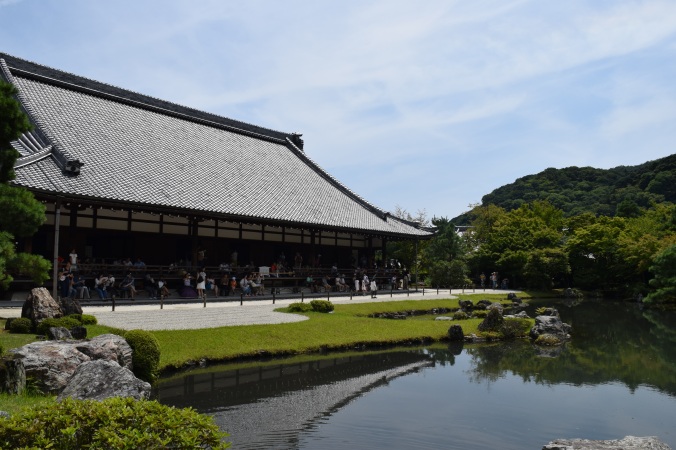
Tenryu-ji
After visiting Tenryu-ji, we took a bus to Arashiyama. This area has a beautiful bamboo forest, with lots of opportunity for taking pictures of the scenery. I found it to be very peaceful despite other people being there. Seeing women wearing yukata brought back to mind old Kyoto, catching a glimpse of the past, if only for a moment. Glimpses of the past could be seen whenever we ran across a stunning natural backdrop, an old temple or shrine, or when left to wander traditional streets near Gion, the area famous for geisha.
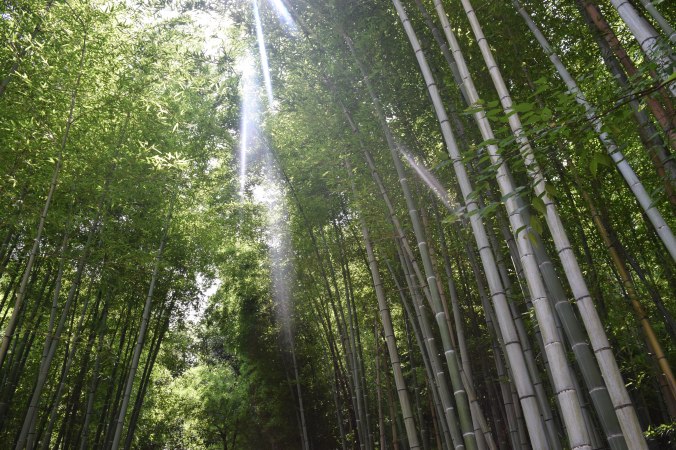
The serene Arashiyama bamboo grove
Mari and I walked around and did some shopping in the Tenryu-ji area on our first day as well. There are many opportunities for buying omiyage, or souvenirs from Japan. Many shops sell ice cream, traditional candies, and other delicacies that should be tried while in Kyoto. Mari and I stopped for ice cream at a shop overlooking Tenryu-ji midway through the day to recharge and escape the heat for a while. Later in the day, we visited Togetsukyo Bridge and stopped to take in the scenery. This bridge is iconic and has appeared in the media. It is stunning and best seen in person. I wanted to live in this area- it was so beautiful and postcard-picture worthy!
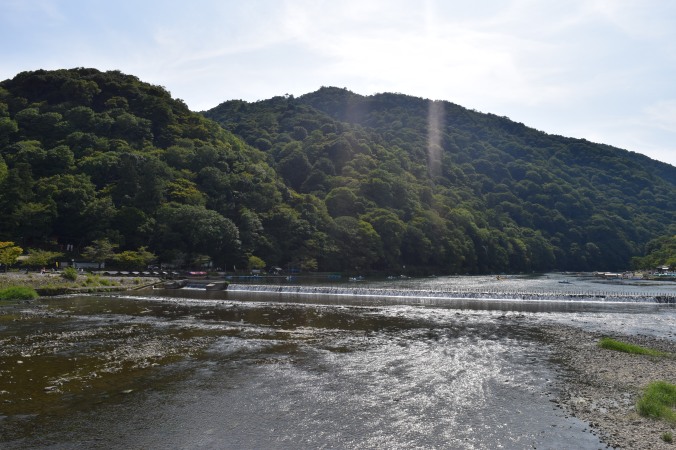
Breathtaking view from the Togetsukyo Bridge
At around 3 or 4 o’ clock, we returned to Kyoto Station to pick up our luggage and check into our apartment where we would be staying for two nights. We were pretty beat after not sleeping well the previous night and having walked around a lot, so we decided against doing too much more sightseeing the rest of the afternoon. After resting up for a bit, we walked around the area where we stayed near Kinkaku-ji to find dinner. We settled on a restaurant that serves okonomiyaki (Japanese style “pancake” that varies, but is made of flour, cabbage, sometimes meat and various veggies) and yakisoba (buckwheat noodles, ours came with meat, veggies, and ginger). The restaurant owner, an older woman, chatted our ear off as we ate our delicious supper. We were happy to consume calories we had burnt off during the day and to have made a new friend.
Mari and I woke up bright and early our second day. We headed to Kiyomizu-dera, which has breathtaking views of Kyoto. Kiyomizu-dera is one of the most famous places in all of Kyoto (it is a UNESCO World Heritage site). Enough has been written elsewhere on this spectacular Buddhist temple. Let the photos speak for themselves.
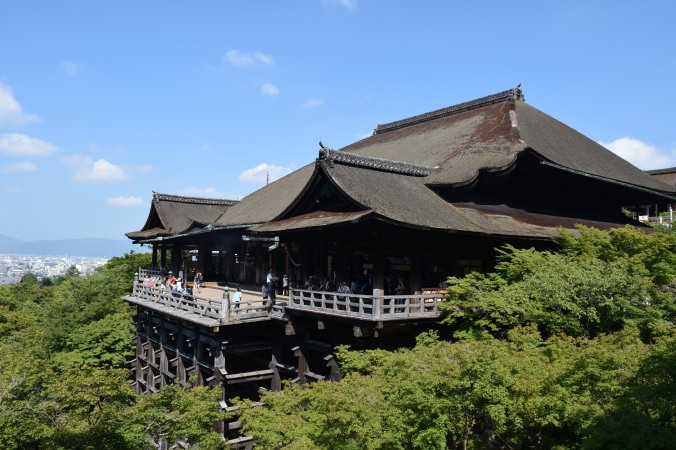
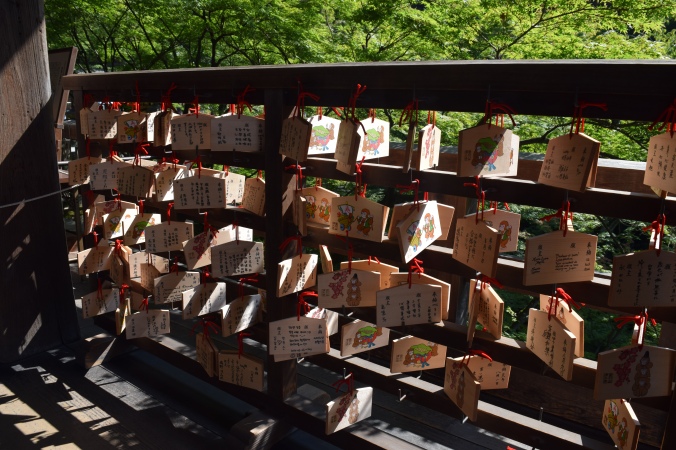
After visiting the temple, Mari and I shopped on one of the streets near the temple. I got caught up in buying omiyage for friends, as well as myself. We met many kind shopkeepers and clerks as we shopped. One of the shopkeepers we met was the 6th generation to be in the same shop in Kyoto. The shopkeeper, a man in his 60’s or 70’s, was very kind and talked with us for a long time. He’s met a few famous people, and has been in a TV commercial (back in 1993 it was an advertisement promoting Kyoto tourism). A singer (I don’t recall who) from the famous group EXILE featured a photo of himself taken in front of this store because he loved the shop so much – that was before he became famous, but it was put into their first album artwork. The shop has been featured in guidebooks, photos, and even in children’s manga. As we were leaving, the shopkeeper gave me a 5 yen coin necklace. “For attracting money,” he said. He also gave me a small charm, and a postcard, and did the same for Mari as well. I feel I made a grandpa and a good friend after talking with him.
Our next stop of the day was a smaller temple we stumbled upon while exploring. We also wandered the streets, poking our heads in other shops along the way. I visited a store selling Studio Ghibli items. We went out for lunch in the late afternoon. At the end of the day, we decided to visit a public onsen, which was more of a bathhouse than actual hot springs as it was indoors. This was my first time at an onsen, so it was quite the experience for me. I actually enjoyed it, and felt no shame being naked with other Japanese women. We’re all human, and in this case, all sweaty and ready to bathe. At onsen, you rinse off at a shower first before getting into a pool/tub area. Some onsen might have a locker to store items. We brought our own towels and shampoo.
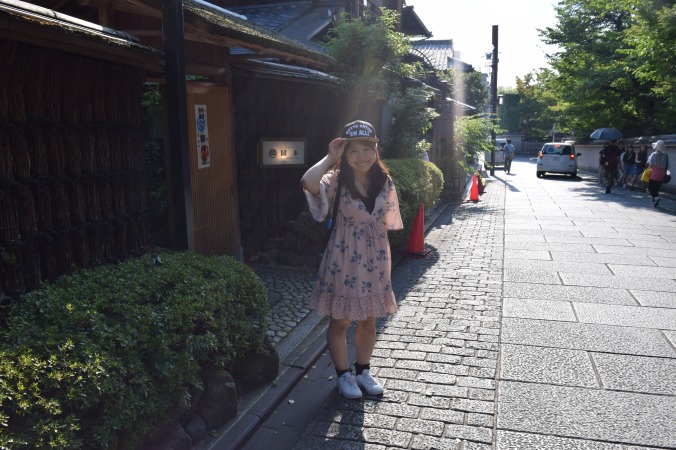
Mari in the streets of Kyoto
For the third and final day, we had a packed itinerary we tried our best to get through. We didn’t get to Ryoan-ji or other places we’d hoped for, but we still managed to visit several places. Our first stop was a short walk from the place we were staying in- Kinkaku-ji, the Golden Pavillion/Golden Temple! It was beautiful to see. There’s not a lot of walking to be had as the Golden Temple is the only thing to really see here, aside from the pond and garden area, which is fairly small. It’s still worth the entrance fee. Unfortunately, visitors are not allowed to see the inside of the temple, which is unfortunate as each floor has a different architectural style.
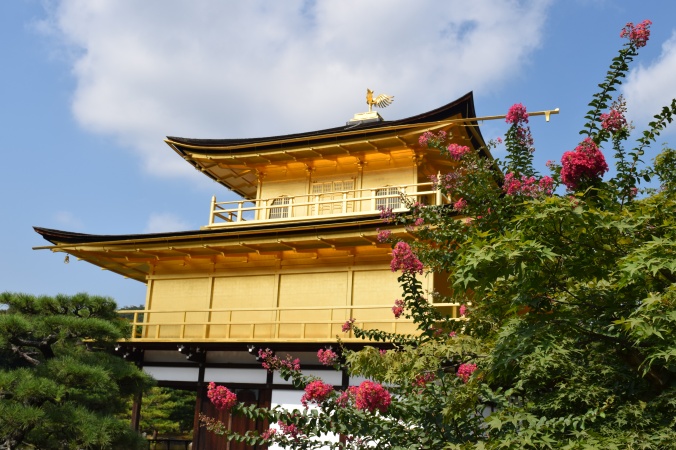
Kinkaku-ji
The stop at Kinkaku-ji didn’t take long at all. We had time to go back and check out of our apartment, and put our bags in a coin locker again at Kyoto Station. From there, we made our way to the place I’d been looking forward to the most: Fushimi-inari Taisha! I had dreamed of walking through the bright orange torii gates of Fushimi-inari for nearly ten years, and that dream finally came true. Fushimi-inari is actually on Mt. Inari, which being a mountain takes some time to climb. I believe it took us about an hour and a half to make it to the top. I was surprised there wasn’t a view from the top, but the walk is still well worth it. Crowds thin out the higher you climb, and the torii gates are older and weathered, and the woods on the mountain are beautiful. The writing inscribed upon the gates are actually the names of businesses and people who have donated money to the shrine, which I wasn’t expecting. Kitsune, or fox spirits kept an ever watchful eye over Inari.
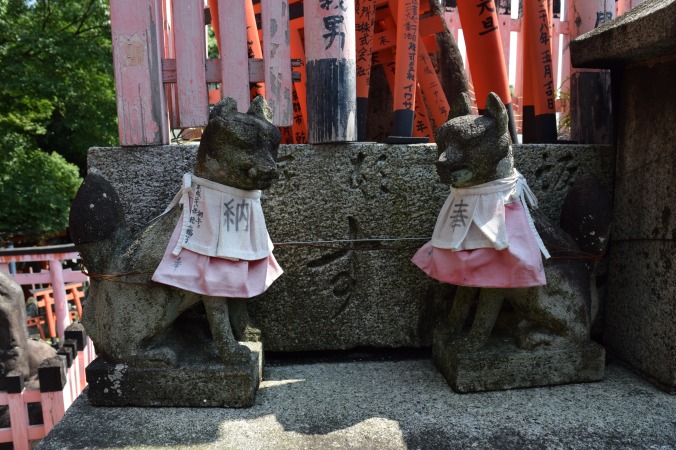
Kitsune at the top of Mt. Inari
Climbing Fushimi-inari is a very peaceful, and even spiritual experience, albeit a sweaty one (wear good hiking shoes). This was definitely my favorite place I saw in Kyoto. On the descent, Mari and I hummed the theme songs from several Studio Ghibli songs. The woods here felt like something out of Hayao Miyazaki’s Spirited Away. I was expecting forest spirits to be just around the corner, watching, waiting. Spirits were around I am sure as it was obon week. Ancestors were likely making their way back to their homes as we hiked the mountain.
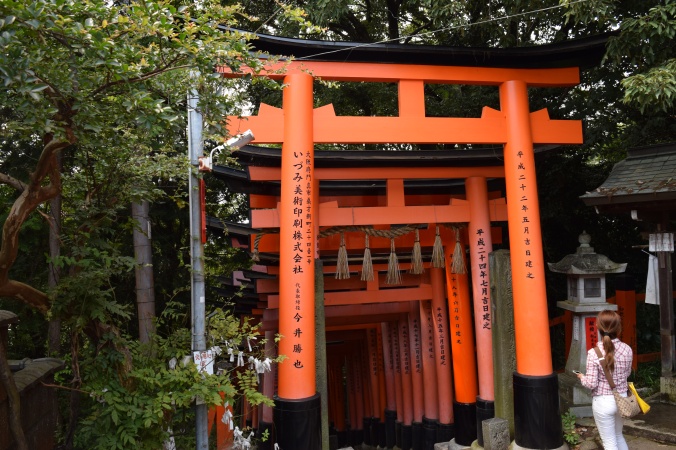
Fushimi-inari took over 3 hours in total. The later afternoon was upon us, and we had time to kill before the day was over. Most shrines and temples close around 5 or 6 pm and we had until midnight before the night bus would leave. Mari did a bit of research and found a boat near Togetsukyo Bridge that would take us out to watch fisherman who would catch fish via the assistance of fire torches. We waited an hour as the sun went down, sipping a drink and taking photos before the boat cruise went out. It was enjoyable to sit on the boat and watch the fishermen use birds and torches to catch fish out of the water. They would reach into the bird’s throats as they caught fish and pull them out. It was quite a spectacle.
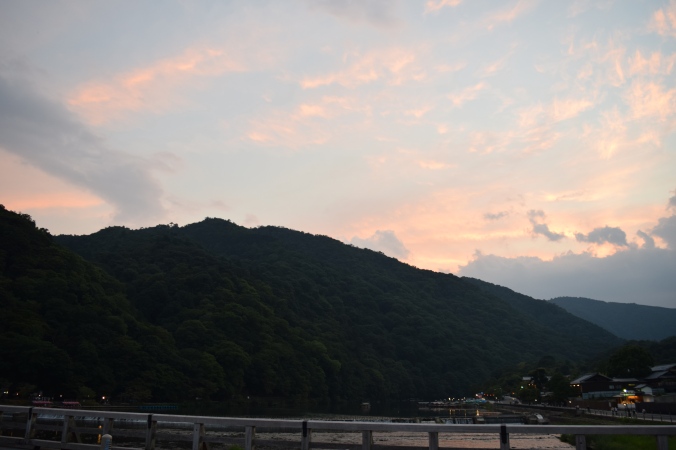
View from Togetsukyo Bridge around sunset
The last thing we did before leaving was to visit a public bathhouse near Kyoto Station to clean off before hopping on a bus for eight hours. I was thinking about the five yen necklace I received as I was spending money in Kyoto and definitely not attracting money my way. At the bathhouse, however, I went to use the vending machine. I wanted to grab a lemon water before catching the night bus back to Yokohama. When I pushed the little lever to get my change back from the money I just put in, it gave me an extra 400 yen!
I will treasure the photos and memories of my Kyoto trip for years to come. I hope to make a trip back again within the next few years.